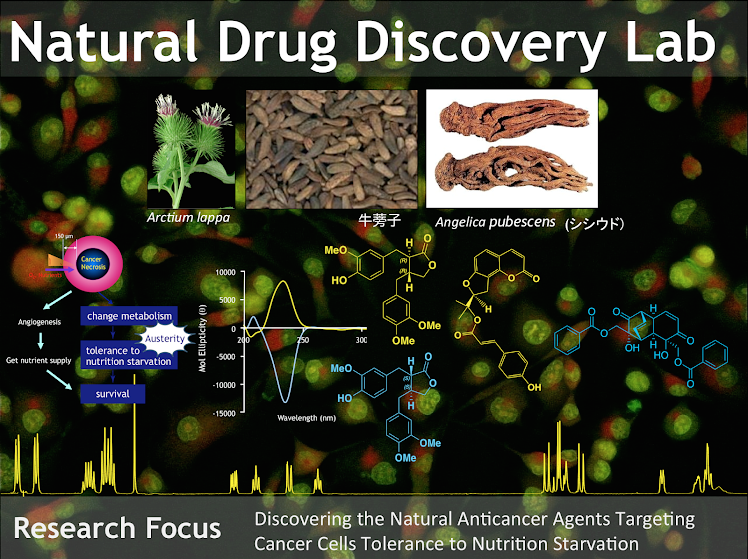天然薬物開発分野
- ヒト膵臓がん細胞(例、PANC-1、MIA Paca2、KLM-1、NOR-P1、Capan-1、PSN-1など)を利用して、がん細胞の栄養飢餓耐性を標的とした(antiausterity
strategy)、各地の伝統生薬(漢方生薬、アユルヴェーダ生薬など)の抗がん活性のスクリーニング。
- 活性を指標にして最先端のクロマトグラフ及び分光分析(NMR,MS,UV,IR,CDなど)技術を活用し、成分を分離・精製ならびに同定による天然薬物資源から栄養飢餓耐性を解除する活性物質(antiausterity
agent)の探索。有望な候補物質は、ヒト膵臓がんのマウスモデルを用いたin
vivoでの抗腫瘍活性効果の評価を行う。
- 活性天然化合物の構造活性相関研究ならびに栄養飢餓耐性を解除する機序の解明。
- FT-NMRおよびFT-MS手法の活用による、活性物質(antiausterity agent)の膵臓がん細胞の代謝に対する影響の解析。
The major research focus of our division is to discover
natural anticancer agents by targeting cancer cells’ characteristic performance
(e.g. tolerance to nutrient starvation) in the tumor microenvironment. Tumor
cells in general proliferate very fast in an unregulated manner and are often
exposed to nutrition and oxygen deficient environment due to poor and
disorganized vasculature. In particular, cells of the clinically hypo-vascular
tumors such as pancreatic cancers have inherent ability to tolerate the extreme
environments of low nutrition and oxygen by modulating their energy metabolism
(austerity). Therefore, to discover natural anticancer agents that retard this
tolerance to nutrition starvation is one of the major research goals of our
division. In order to achieve this goal, we are actively engaging in the
following research projects.
- Antiausterity strategy-based screening of traditional medicinal plants from different origins (e.g. Kampo medicines, Ayurvedic medicinal plants, etc.) utilizing human pancreatic cancer cell lines (e.g. PANC-1, MIA Paca2, KLM-1, NOR-P1, Capan-1, PSN-1, etc).
- Discovery of antiausterity agents from natural medicine resources through bioassay-guided isolation, identification by using state-of-the-art chromatographic and spectroscopic techniques (e.g. NMR, MS, UV, IR, CD). Successful candidates will be evaluated for their in vivo anti-tumor activity by using the pancreatic cancer mouse model.
- Investigation of the structure-activity relationship of the active natural compounds and their mechanism of action against cell survival pathways.
- Study of the effect of antiausterity agents against metabolism of cells utilizing FT-NMR and FT-MS approach.
Subscribe to:
Posts (Atom)


